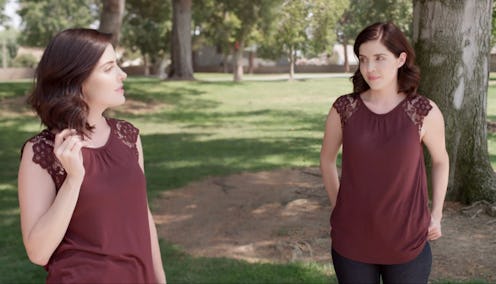Entertainment
These Wild, Real Life Stories About Twins & Crime Sound Like Lifetime Movies
Jen Lilley stars in the upcoming Lifetime drama, Twin Betrayal, which premieres on Sunday, April 8. Lilley juggles two characters: One, a struggling single mother battling for custody of her family, and the other, her ambitious and morally questionable twin sister. The vicious twin murders their wealthy father and then frames her innocent sister for the murder. It sounds like a Lifetime drama, alright, but has this ever happened in real life? Is Lifetime's Twin Betrayal a true story?
Not exactly, but that doesn't mean that twin-related murders and set-ups haven't been a common occurrence for as long as crime itself. Growing out of the same egg and same sperm makes the DNA of identical twins nearly impossible to tell apart, which means it's tough for scientists and the law to determine with any real certainty which twin was actually present at the scene of a crime.
In a 2016 article for the Chicago Tribune, reporter Steve Schmadeke described one such instance as it unfolded before him on September 23, 2016, and even he couldn't help but remark that it would make a good movie:
"Karl Smith was on the witness stand Thursday at the Leighton Criminal Court Building, making an admission seemingly ripped from a made-for-TV movie. Smith confessed to a murder that his brother, Kevin Dugar, has been in custody for since 2003."
According to Schmadeke, Smith had recently been convicted of armed robbery and murder and was already sentenced to 99 years in prison. He had nothing to lose by confessing to his brother's murder, and so decided to give it a shot. At the time the article was published, there was no word on whether or not Smith would be convicted and Dugar would be acquitted. The Illinois Department of Corrections reports that Dugar is still in prison, as is Smith.
And, theirs is hardly the only case of twins complicating the conviction process.
According to Time, twins Sunny and Gina Han were close, connected sisters until they were driven apart by various struggles. Sunny did some jail time for stealing a friends credit card. Then Gina allegedly stole $40,000 from friends and family, and Sunny pressed charges against her sister. Eventually, Gina became involved in what prosecutors would claim was a plot to murder her sister. Per Time, in 1998, Gina was sentenced to 26 years in prison for attempted murder.
Time also reported on another situation, this time involving a pair of twin brothers from Berlin, Germany. In a 2009 robbery at the Berlin department store KaDeWe, three men wearing masks escaped with more than $6.5 million in jewelry and merchandise. The thieves left behind one rubber glove. The glove contained traces of the DNA of either Hassan or Abbas O. Because their genetic information is 99.99 percent identical, the authorities couldn't reach a decision about which brother to convict. "From the evidence we have, we can deduce that at least one of the brothers took part in the crime," the court case, as reported by Time, reads, "but it has not been possible to determine which one." No charges were filed.
It seems that this is the similar premise which will feature in Twin Betrayal: one sister frames another for a crime marked with her own DNA, and their too-similar genetic makeup makes it impossible for forensic science to prove her innocence.
In the world of science, however, 2009 was a very long time ago. Nearly a decade has elapsed since Hassan and Abbas walked free, and new forensic developments might just make it so that such a situation will never happen again. According to an article published by the BBC, scientists working in Ebersberg, Germany are on the verge of being able to distinguish between the DNA of identical twins.
"The human genome consists of a three-billion-letter code," says Georg Gradl, one of the experts studying at Eurofins lab. "If the body is growing, or an embryo is developing, then all the three billion letters have to be copied. During this copying process in the body there are 'typos' [mutations] happening." The BBC reports that as Gradl and his team carried out their studies on identical twins, they actually found a few dozen slight differences in the DNA.
While the progress Eurofins is making has major implications for court convictions when it comes to crimes involving twins, it's still a long way off from actually being used in court. In an interview with the BBC, Laura Walton-Williams of the Forensic and Crime Science Department at Staffordshire University referred to Eurofins's twin test as "a very exciting development… a significant step forward in forensic DNA analysis." Yet she also cautioned that much more testing will have to be done before courts can actually hold up the tests as hard evidence.
As for what happens in the Lifetime movie — you'll just have to tune in.
